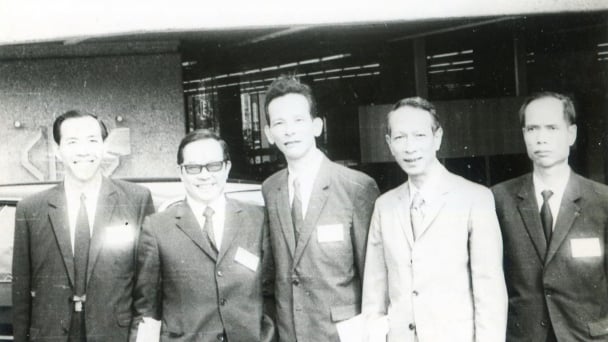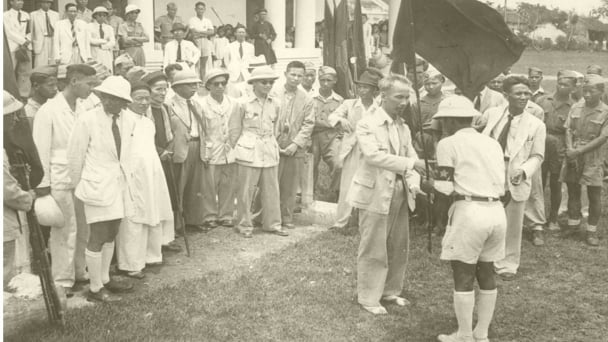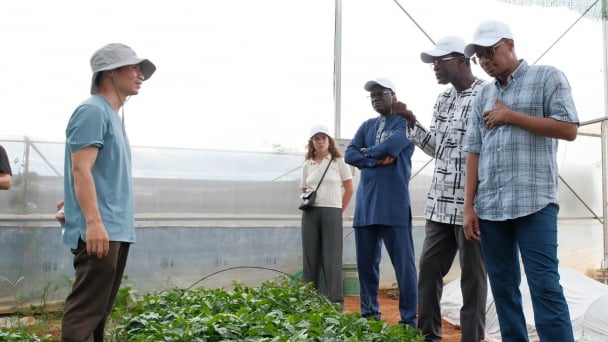September 8, 2025 | 08:14 GMT +7
September 8, 2025 | 08:14 GMT +7
Hotline: 0913.378.918
September 8, 2025 | 08:14 GMT +7
Hotline: 0913.378.918
Over the past 80 years, Vietnam has undergone a remarkable transformation. From a nation once forced to import rice to stave off famine, it has risen to become one of the world’s leading agricultural exporters, with export values reaching USD 62.5 billion in 2024. This monumental achievement rests on the sweat and ingenuity of millions of farmers, transformative government policies, and, crucially, breakthroughs in science and technology.
In cultivation, scientists have introduced high-yield, high-quality crop varieties resilient to climate change. Where a hectare of rice once produced only a few hundred kilograms of paddy, yields now consistently reach 6–7 tons, and sometimes even higher.

Science and technology supporting the nation's farmers. Photo: Pham Hieu.
A clear trend toward biological agriculture is emerging. Biological plant-protection products now account for 17 percent of the market, with a target of 30 percent. Fertilizer imports have been cut in half, from 120,000 tons to just over 60,000 tons. The long-term goal is to introduce four million tons of organic fertilizer into production annually. Behind these successes lies a network of research institutes and scientists working quietly to control pests and diseases, safeguarding golden harvests for farmers.

Machines replacing human labor in the fields. Photo: Pham Hieu.
The livestock sector has also recorded spectacular advances. Through applied science and technology, a single sow can now birth and raise 32 - 34 piglets a year, with faster growth and higher survival rates. Just as importantly, veterinary medicine has matured significantly. Vietnam now proactively researches and produces critical vaccines for diseases such as foot-and-mouth, blue-ear, and avian influenza, providing a strong shield for the nation’s livestock.
Biosafety in animal husbandry has become the foundation of epidemic prevention. From smallholdings to large-scale farms, strict biosafety protocols are now standard, reducing disease risks, stabilizing the food supply, and enhancing the competitiveness of Vietnamese agricultural products.
Forestry has undergone a complete metamorphosis. In 2004, when the Law on Forest Protection and Development was first implemented, national forest coverage stood at just 37 percent. Today, it exceeds 42 percent. This growth is not only quantitative; forest quality has also improved significantly, providing stable incomes for millions of households.

Science and technology help reduce labor while increasing productivity and quality in agricultural production. Photo: Pham Hieu.
The Forest Environmental Services Fund has seen steady expansion, fostering closed-loop value chains from seedling production to harvesting, transport, and processing. Forests are no longer just the “green lungs” protecting the environment; they have become a source of sustainable livelihoods, contributing meaningfully to green growth and the circular economy.
Aquaculture faces three major challenges: breakthroughs in farming techniques, improved deep-processing capacity, and innovation in harvesting technology coupled with sustainable conservation. In recent years, Vietnamese seafood has reached more than 160 countries and secured its place in demanding markets such as Europe, the United States, and Japan.
Looking ahead, science and technology are opening new horizons for agriculture and the environment. These include remote sensing maps for economic planning, big-data applications for disaster prevention and climate adaptation, soil-health improvements, and high-quality OCOP (One Commune, One Product) goods that embody regional identity and are ready for global markets.
If Vietnam’s 80-year journey demonstrates how science and technology have reshaped agriculture, then the story of Tractor and Agricultural Machinery Co., Ltd. (Tamac) is a quintessential chapter.
Established in 1959 with the mission of building a mechanical factory for agricultural tools, Tamac began with just a few dozen old machines, a 2,000-square-meter workshop, and 131 workers. In its early years, the factory produced simple tools—plows, harrows, hoes, and shovels that nonetheless played a vital role in post-war recovery.

Tamac's exhibit at the National Achievement Exhibition, commemorating the 80th National Day (1945 - 2025). Photo: Pham Hieu.
A decade later, the factory advanced to producing the 12-horsepower “Bong Sen” tractor, pesticide sprayers, and rural transport vehicles. This marked Tamac’s transition from simple toolmaker to a true driver of agricultural mechanization. Today, after 65 years, Tamac is an industry leader under VEAM (Vietnam Engine and Agricultural Machinery Corporation) and the Ministry of Industry and Trade, partnering with farmers nationwide, from flatlands to mountains.
What defines Tamac is its spirit of continuous improvement. Throughout its 65-year history, the company has understood that no single machine fits every field.
“Every field, every plot of land has its own unique characteristics, from terraced paddies in the mountains to the vast plains of the delta. Therefore, we are always researching and optimizing each type of machine to best suit real-world production”, said Ms. Nguyen Thi Hoa, a company representative, at Tamac’s display in the A80 National Exhibition.

Ms. Nguyen Thi Hoa discusses the story of mechanization with a reporter from the Agriculture and Environment Newspaper. Photo: Linh Linh.
In the exhibition hall, Tamac’s new generation of tractors, gearboxes, and sprayers do more than showcase technological achievement; they tell a story of deep understanding of the land and a journey of innovation shaped by listening to farmers. These products reflect the landscapes they are built for: the windswept highlands, the arid central coast, and the immense rice baskets of the Mekong Delta.
Today, Tamac focuses on developing four-wheel tractors, aquaculture gearboxes, and a range of new farm machinery. A key innovation is that products are no longer single-purpose but are designed to be multifunctional and easily customizable. A single tractor can plow and harrow, then be adapted for tending orchards, planting flowers, or preparing vegetable beds. With just a few component changes, farmers can repurpose their machinery, significantly reducing investment costs.
“This approach not only increases labor efficiency but also supports the development of a more flexible, modern, and sustainable agricultural model,” Ms. Hoa noted.
This philosophy, placing farmers’ practical needs at the center of technological innovation is Tamac’s cornerstone. Each machine is built not only to replace manual labor but also to open doors to new production models, connecting farmers to the trends of smart agriculture and modern mechanization.

Visitors at the exhibition booth. Photo: Pham Hieu.
“Before, people had to plow, harrow, and plant every rice seedling by hand. Now, machines can handle the entire chain: plowing, planting, harvesting, and milling. A farmer only needs to invest once for long-term use, reducing labor while increasing productivity and profit,” Ms. Hoa explained.
With such corporate partnerships, farmers are not only cutting costs and boosting efficiency but are also transitioning from subsistence farming to large-scale commercial production capable of meeting the strict demands of domestic and international markets.
Science and technology have long been recognized as a key determinant of a nation’s standing. Global experience shows that countries that invest wisely in this area make extraordinary leaps. For Vietnam, science and technology have been a focus for eight decades, but their full potential has yet to be unlocked.
Now entering a new phase, particularly in agriculture and the environment, the country has identified science and technology as the core driver of growth. This commitment is enshrined in directives such as Resolution 57 on the development of science, technology, innovation, and national digital transformation. With strong human resources, improving infrastructure, and increasingly autonomous research institutes, these policies are opening the way for science and technology to truly become a launching pad, turning the passion of scientists into tangible achievements that serve national development.
Translated by Dieu Linh

(VAN) Within the headquarters of Vietnam’s 24/7 national disaster forecasting service, a main conference hall is named for Tran Van An.
/2025/09/03/4944-3-184250_214.jpg)
(VAN) Land statistics and inventory have always played a crucial role as an effective management tool, enabling the State to firmly grasp, rationally allocate, and efficiently utilize this immense resource.

(VAN) The Prime Minister calls for stronger traceability and quality assurance of export farm and fishery products, and a faster customs process for businesses.

(VAN) Marking the 80th anniversary of the agriculture and environment sector, historian Duong Trung Quoc recalls the nation’s earliest efforts to build and protect dykes in the days immediately after independence.
/2025/09/01/1540-3-180406_278.jpg)
(VAN) Consolidating land fund development organizations aims to ensure transparent management, secure proactive resources, and support socio-economic development.

(VAN) Through South-South cooperation, Vietnam is steadily asserting its role as a global food security creator, contributing to a more sustainable and equitable world.